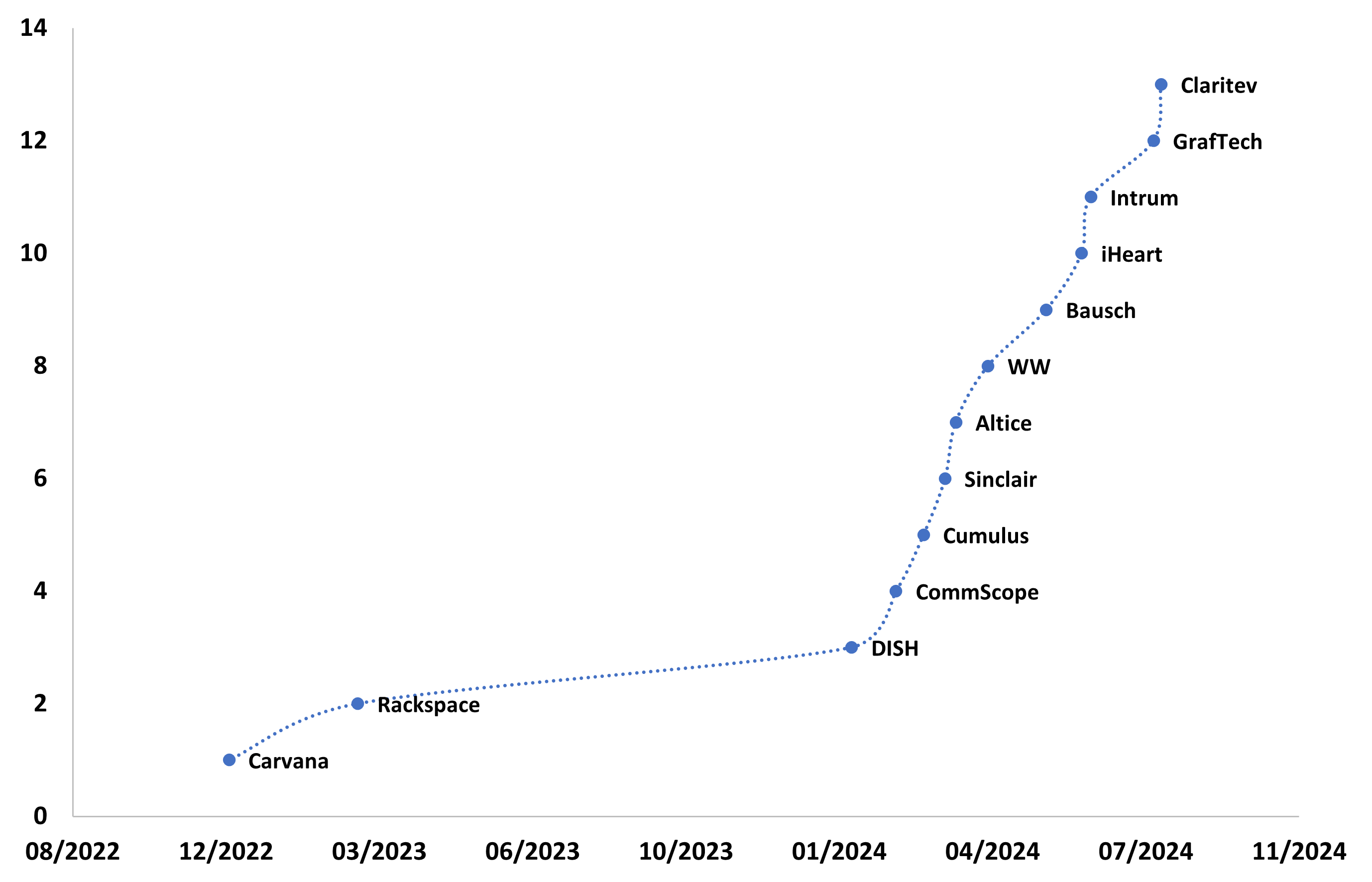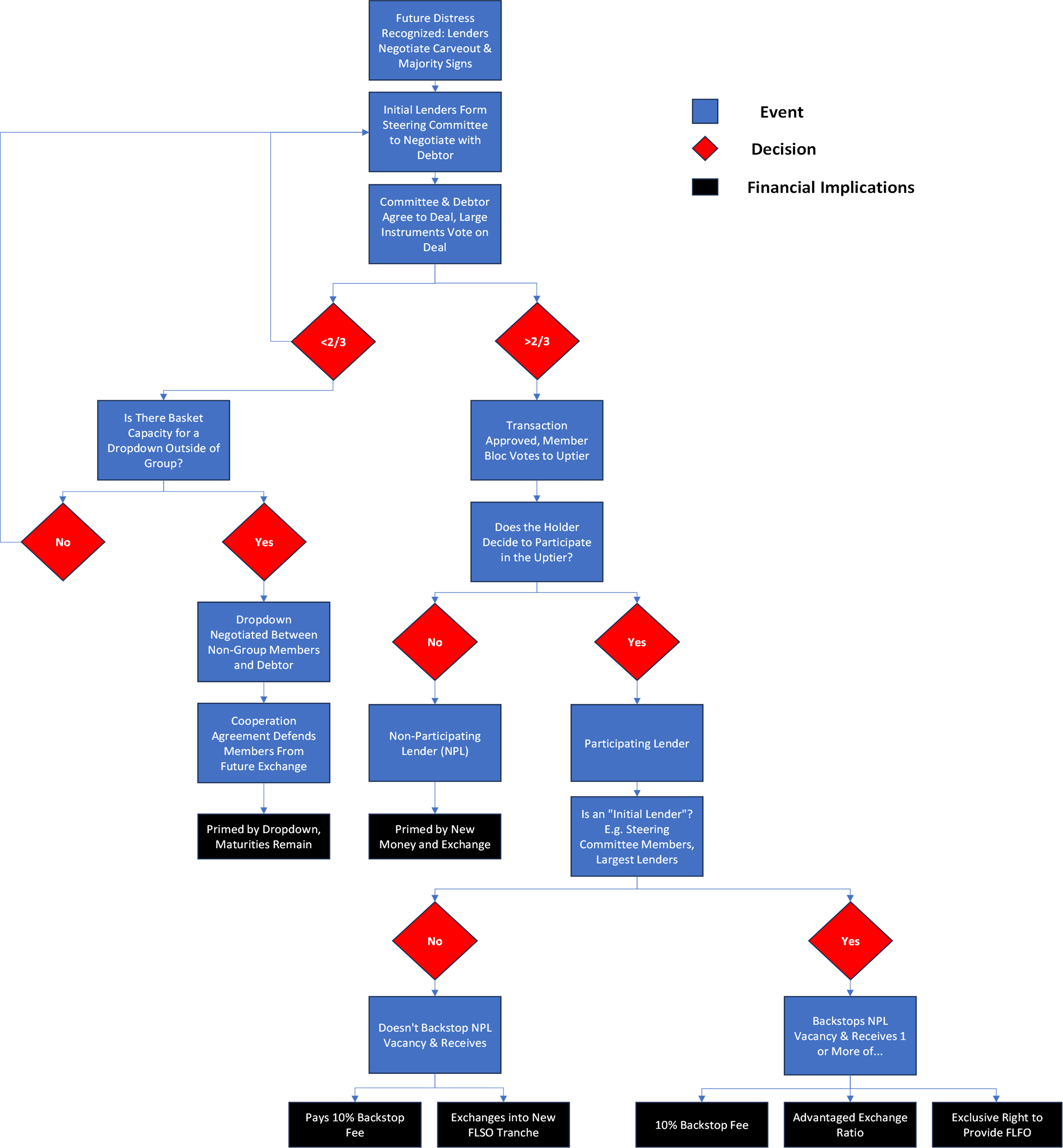By Brett Seaton
Background
Cooperation agreements (Co-Ops) with a carveout emerged over the past two years as an innovation in the landscape of corporate restructuring, shaped by the rise of covenant-lite loans and lender-on-lender violence. The “dropdown” transaction pioneered by J. Crew in 2016 and the “uptier” created by Serta Simmons in 2020 have given debtors new methods of reducing debt by pitting lenders against one another. The dropdown raises new cash and reduces debt by creating a new subsidiary, moving assets to that subsidiary, taking out new debt against those assets, and then using the new cash to offer to buy back old debt. An uptier takes out new super senior debt and then exchanges for existing debt. In both of these transactions, the debtor usually needs a majority of lenders to facilitate the exchange or offer for existing debt. These two transaction types, along with a few other techniques have collectively become known as liability management exercises, or LME. Debtors have rapidly adopted LME to preserve their equity value rather than enter an in-court Chapter 11 process which would likely eliminate their claim on the business (Figure 1).
Figure 1: LME Growth 1980-2024 (Moody’s)
 Co-Ops help protect lenders from both transaction types by binding together a majority of lenders who will vote no to the exchange should their demands not be met. As the amount of LMEs has grown rapidly over the past few years, so too have Co-Ops grown to bind lenders together before the debtor can divide and conquer them (Figure 1).
Co-Ops help protect lenders from both transaction types by binding together a majority of lenders who will vote no to the exchange should their demands not be met. As the amount of LMEs has grown rapidly over the past few years, so too have Co-Ops grown to bind lenders together before the debtor can divide and conquer them (Figure 1).
Figure 2: Co-Ops Signed by Public Companies (9fin)
 What is a Co-Op?
What is a Co-Op?
The original Co-Op (without a carveout) evolved as both an offensive and defensive tool for lenders since its introduction in the late 1990s. The Co-Op binds together a majority of lenders to negotiate collectively with the debtor—forbidding individual negotiation or participation in a LME without the group’s consent. Due to the private nature of these agreements, I interviewed two leading experts on Co-Ops to understand their history and current trends—Scott Greenberg and Ross Rosenfelt. Scott Greenberg, partner at the law firm Gibson Dunn and global head of their business restructuring unit, is one of the leading experts on the formation of Co-Ops for lenders. Greenberg’s experience is that modern Co-Ops address more potential transactions and are carefully crafted to ensure the agreeing lenders’ (signees) securities trade at a premium.
The Need for a Carveout
Co-Ops are successful in creating equal recoveries for signees but they fail to address expenses taken on by the largest lenders to negotiate with management and structure a deal. Imagine you own 99% of the debt in a business that is in distress—you hire lawyers, consultants, and restructuring advisors to help turnaround the business and consider out-of-court transactions that could provide the business with the liquidity and maturity extension it sorely needs. By being actively involved in the restructuring process, you also lose the ability to trade the firm’s securities, leaving you exposed to massive losses should the debt trade down in the public market. If a transaction is executed, is it fair that should you get the same share as the 1% who did nothing? The distressed debt market is in the process of answering this question with a resounding “No.” Carveout Co-Ops recognize the disproportionate expenses and risk taken on by the largest lenders in a capital structure by providing incentives to them when the transaction closes (Figure 2).
What is a Carveout Co-Op?
The Carveout Co-Op is growing in popularity (Scott Greenberg, interview). It is nearly the same as a traditional Co-Op except that it provides “carveouts” in the contract for signees before an agreed upon date to earn outsized economic benefits in a future transaction.
Figure 3: A Restructuring Process w/ A Carveout Co-OP
 Ross Rosenfelt, managing director at Oaktree Capital Management, is a member of the State Bar of New York and Oaktree’s in-house expert on cooperation agreements. He explains that Carveout Co-Ops have become popular to decrease free-riding (the 1% discussed earlier) and compensate large lenders for the expenses they incur structuring the agreement and negotiating with the borrower should it choose to engage (Ross Rosenfelt, interview). Lenders who help structure the Carveout Co-Ops also provide new money in the impending transaction, which is advantageous because it is usually the most senior debt in the capital structure and has higher interest rates than would normally be provided for such senior debt. The carveouts that the advantaged lenders who enter the Co-Op receive are structured either as a “backstop fee” or as an improved exchange rate with newly issued instruments. The backstop fee is a fee that the advantaged lenders receive in exchange for security that the advantaged lenders on the steering committee will provide the financing in full should the members of the Co-Op decide not to participate.
Ross Rosenfelt, managing director at Oaktree Capital Management, is a member of the State Bar of New York and Oaktree’s in-house expert on cooperation agreements. He explains that Carveout Co-Ops have become popular to decrease free-riding (the 1% discussed earlier) and compensate large lenders for the expenses they incur structuring the agreement and negotiating with the borrower should it choose to engage (Ross Rosenfelt, interview). Lenders who help structure the Carveout Co-Ops also provide new money in the impending transaction, which is advantageous because it is usually the most senior debt in the capital structure and has higher interest rates than would normally be provided for such senior debt. The carveouts that the advantaged lenders who enter the Co-Op receive are structured either as a “backstop fee” or as an improved exchange rate with newly issued instruments. The backstop fee is a fee that the advantaged lenders receive in exchange for security that the advantaged lenders on the steering committee will provide the financing in full should the members of the Co-Op decide not to participate.
While lenders almost always participate in the new money investment considering how attractive the interest rate and protections are, some collateralized loan obligations (CLOs) are contractually unable to participate, requiring the advantaged lenders to provide the backstop. The backstop fee is a method of creating differential treatment within a Co-Op to recognize the difference in expenses incurred and time spent by the largest lenders in support of all holders. The coupling of these fees with the functionality of backstopping the cash infusion is questionable due to increasing flexibility from CLOs and the attractiveness of the highly secured and high interest rate new money security. Nonetheless, these fees provide necessary incentives for large lenders to join a Carveout Co-Op and create a collective defense against aggressive debtor-led LME.
Conclusion
LME has skyrocketed since the advent of the dropdown and the uptier and continues to be a growing portion of global defaults. The Co-Op has been lenders’ defensive weapon to keep debtors from reducing debt by preying on portions of the capital structure. Although its egalitarian treatment of signees is admirable, the traditional Co-Op fails to recognize realities on the ground of disproportionate expenses borne by active participants in the restructuring process. The Carveout Co-Op resolves this issue and restores balance to the credit market by creating an agreement tight enough to block coercive LMEs, yet flexible enough to reward lenders who shoulder the heavy lifting and might otherwise have pressed for richer recoveries at others’ expense. Without the middle ground that the Carveout Co-Op offers, aggressive LME with horrible consequences to non-participating lenders would be more common, raising the cost of borrowing for businesses and creating a deadweight loss to society. Carveout Co-Ops provide large lenders with an incentive, small lenders with near-equal treatment, and a truce to weary warriors in the lender wars.
Brett Seaton is a Stevens Center student fellow. The views and ideas expressed in this post are those of the author and do not necessarily represent those of the Wharton School or the Wharton Initiative on Financial Policy and Regulation.


